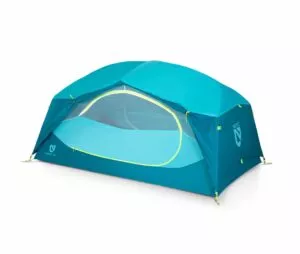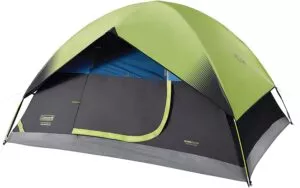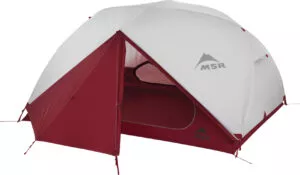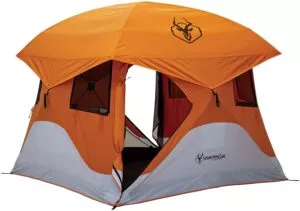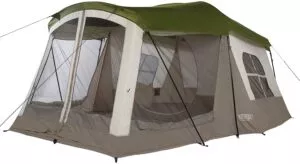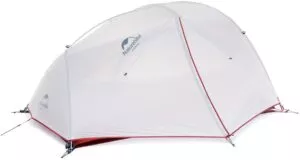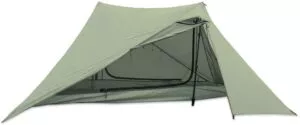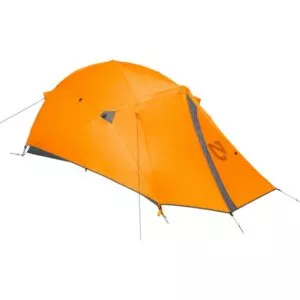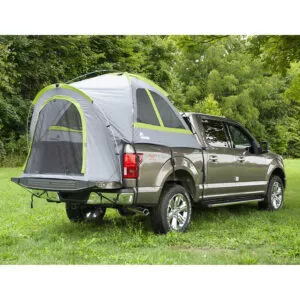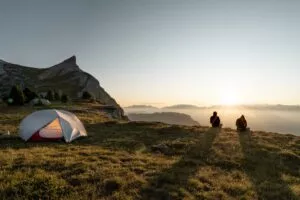
The Best Camping Tents in Canada
Canadians get the short end of the stick sometimes. As a country with some of the most beautiful landscapes in the world and rife with incredible camping opportunities, some of the best outdoor products are hard to find or unavailable for Canadians. Camping has grown in popularity immensely, but with so many people looking for tents, finding the right one for you might be a challenge this summer.
There is nothing wrong with going to Canadian Tire or Costco and buying the cheapest tent – these shelters can be solid enough for car or backyard camping, granted the conditions do not get too extreme. However, for many applications, these tents will not do: the flimsy materials, less-than-stellar waterproofing, and heavy components may make an upgrade necessary.
If you are planning on spending lots of time in your tent this summer, or you have that big, backcountry trip planned and you do not what the conditions will be like, it definitely makes sense to look into the best camping tent options.
Below is our list of some of the best tents available in Canada.
Our top choices
What to look for when buying a tent
What type of tent you need relies on many factors, but one of the most important things to think about is the outing you will be going on. Backpacking trips, for example, will call for different features on a tent than camping at a designated campsite. Before shopping, we recommend thinking about what kind of adventures you will need a tent for, and which of the following factors will be important for those uses. Some avid campers will even collect a handful of tents for different situations!
Durability – One of the first sacrifices when going for a value-brand tent is durability. Cheaper materials mean more possibilities to fail. If you want to try out camping, or you are car or backyard camping, these tents are fine, and you will not be too mad if you poke a hole in it. But durability is of high importance if you are investing a chunk of change into a better-quality tent. Looking into the denier (or thickness) of the fabric materials, what type of pole construction the tent has, and how the seems are sealed are some of the things you can research when looking into the durability of a tent, however, durability ultimately comes down to user experience.
Features – There will be lots of additional features different tents offer, and you will not need all of them. We suggest considering what are “must-have” features that you will need. For example, many tents do not have a vestibule, but for me, this type of area is a must since I will not want to store my bag inside my tent. Common features that many tents include are gear pockets, included footprints, and electrical ports to run an extension cable into your tent.
Set Up – We recommend watching the setup of the tent you are looking at since this is a factor you will not be able to consider when only looking at the specs of a tent. The last thing you will want to do after driving or hiking hours to a campsite is to fight with a difficult tent. We recommend setting up your tent before camping as well. If you expect to camp in bad weather, we suggest looking into tents that can be set up with the rainfly first, to keep the inner tent dry if you need to set up in heavy rain.
Space – Consider how much space you will need to be comfortable in your tent. If you are camping with others, this is a big consideration, as if your tent is too small, you will be sleeping like sardines and nobody will be comfortable. There is nothing wrong with going a size up, a 3-person tent will sleep 2 very comfortably. However, we generally think you will be better with multiple tent setups than opting for 6 and 8 person tents, as more tents are versatile, easier to set up, and ultimately could be cheaper in the long term too. For backpackers, considering the packed size of the tent is very important, as a tent that takes up a lot of your pack size could mean difficulties packing.
Ventilation – Ventilation is a very important aspect of tents, as it helps regulate the temperature inside the tent and reduces condensation from building up. Lots of tents will feature an inner tent that has breathable mesh and a rain fly with pockets that open to increase the ventilation. Ventilating a tent properly is highly recommended, as the last thing you want to wake up to is damp gear as a result of condensation build-up.
Weather Resistance – One of the most disappointing things that can happen when camping is being hit by bad weather. Ideally, you could only camp when the forecast is nice, however, many people will have camping reservations months in advance and will be expecting to go rain or shine. When hit by a torrential downpour, the last thing you want is a leaking tent. The further you camp away from a weatherproof shelter, the more important it is your tent can handle elements. Your tent should be solidly waterproof in the case of a bad storm, but also sturdy enough to handle whipping winds, or even snow if you will be in the mountains. Factors to look into include the material and denier of the rainfly, how the seams are sealed, and if the tent includes a waterproof “bathtub” floor or footprint.
Weight – Weight might not be a consideration at all if you primarily car camp, but it is a huge consideration if you plan on backpacking your gear to your campsite. Chances are, if your pack is too heavy you will not be content until you reach your campsite. The tent will be one of the heaviest things any backpacker will be packing in, alongside your sleeping bag and the pack itself, so buying a tent that is on the lighter end of things will shed lots of weight off of your base pack weight. Even if your hike is a short trek from the parking lot, some people will not want to lug 20 or 30 pounds from their car. For backpackers, we suggest looking for tents that are 5 pounds and lighter – but consider that the more weight you shave off, the pricier the tent will be.
Our methodology
Beyond all other factors, the driving force of this buying guide is availability for Canadians. There are countless tent guides out there, but very few are entirely available in Canada, which can make the search difficult. With a commitment to quality, we researched many tents that users from all over the web had good experiences with, generally only looking at tents with an average online score of 4 stars or higher. From there, we considered a wide range of other factors, including price, comfortability, and specifications of each tent. Each tent is going to be suited for different purposes, so one of the more important things to keep in mind when shopping for a tent is your use of the tent.
As someone who obsessively researches their own camping gear to make their own trips memorable, it was important that we put significant research into finding the best tents available in Canada. We put over 25 hours of research into tents that are readily available to Canadian nature lovers.
Best 2-person tent
Nemo Aurora 2-person
Want a tent that can do a little bit of everything, and does everything well? The Nemo Aurora branches comfort with lightweight construction, for a 3-season tent that is versatile for whatever outdoor adventure you are on.
The Nemo Aurora features a floor with dimensions is 2.23m x 1.32m (or 7’3” x 4’3”) making it a solidly sized tent for two people. With an inner height of 1.12m (or 3’8” tall) and vertical walls for improved headspace, the Aurora has ample space for two people to sleep or hang out inside, while still being compact. With two doors and a vestibule on each side, the Nemo Aurora has excellent versatility and livability, as well as ample space to store any gear you have brought along. When packed, the Aurora is 18x58cm, and altogether weighs 2.47kg, however, if you pack the Aurora minimally – just the tent, poles, and the minimum number of pegs and guylines – the Aurora only weighs 2.08kg. While not ultralight by any means, this tent is still perfectly usable on a backpacking trip.
Set up of the Aurora will be easy, albeit slightly different due to the Aurora’s tent pole design, which is designed to improve the space inside the tent with more vertical walls. The Aurora features an internal tent composed primarily of mesh, with a rainfly and included tent footprint to improve longevity and waterproofness of the floor of the tent. Unfortunately, we are not sure if you can set up the rainfly first – but judging from the setup, we doubt that this option will be available, due to how the poles contour to the inner mesh tent. Aurora sells Pawprint, a snap-in floor liner that can easily be set up in the Aurora and protects the tent from your pet’s nails.
The Aurora handles poor weather well, with 68D Polyester for the fly and floor of the tent, which can effectively handle rain up until its saturation point. The Aurora’s frame is sturdy and can handle winds, and a properly guy-lined rainfly can cut the wind, stopping gusts of wind from crashing into the vertical sidewalls. One user raved about the quality of the rainfly keeping heat inside the tent, which combined with effective ventilation options make the tent an effective 3 season tent.
Overall, users seem to really enjoy using the Nemo Aurora 2p tent for both car camping and backpacking. Users appreciate the tent’s interior size and headroom while being a versatile tent that they can use for most situations. However, there are some flaws that one should consider before purchasing the Nemo Aurora. One is the door features a single zipper, which makes opening and closing the door more finicky than it needs to be. One user complained about a lack of guy line required to guy out the tent properly in windier conditions. The final knock against this tent is the overall weight: as a tent that is versatile for most uses, the tent is on the heavier side of backpacking tents, and if this is your primary purpose, you may want to look to shed some weight with a different tent. However, for a versatile tent, you can do a little bit of everything with, we highly recommend the Nemo Aurora. Need to go a little bigger? The Aurora is also available at a 3p option.
Pros
- Roomy tent with lots of space for 2 people and their gear.
- Solid 3-season performance thanks to its effective weatherproofing and ventilation.
- Versatile enough for car camping or backpacking.
Cons
- Only one zipper per door.
Best 3-person tent
MSR Elixir 3-person
While a 3-person tent seems like an awkward number of people to accommodate, these tents can be some of the most versatile, with an ideal size for couples who bring their dogs along or want a little bit of extra room. While there are thousands of tents available at this size and price range, the MSR Elixir 3 is a durable, dependable tent from one of the best tent makers around.
When set up, the Elixir 3 is 3.34m by 2.13 m (or 10’ by 7’), with an internal tent size of 1.72m by 2.13m (or 5’6” by 7”). The Elixir 3 is a low-profile tent, with only a little over 1 meter of height (or 3’4”), so you will need to crouch and shimmy to get around. With its floor area that is bigger than many other 3p tents and a decent amount of headroom thanks to its dome-like construction, you can easily squeeze 3-medium size people inside without having to worry about elbowing each other in your sleep. The Elixir 3 does have double doors, each with its own vestibule, so getting in and out is easy, and each vestibule can keep your bag or your gear dry and out of sight. The tent weighs 3.2kg (7.1 lb) and its dimensions are 20” x 8” (51 x 20 cm), so while this tent is okay for backpacking, it is not the best choice either.
Set up of the Elixir 3 is very fast and easy, made easier with colour coding of poles, clipping and webbing. When setting up the tent, you can opt to set up the tent entirely, or for a fast-packing option, you can skip the mesh interior, and set up with just the footprint, poles, and rainfly (although knowing Canada’s mosquitos in the summer, you will not see us doing this anytime soon). One downside is that if you do wish to set up the full tent, you cannot set up the rainfly first, which may put a little bit of pressure on if it is looking like it is starting to rain, but ultimately, setting this tent up in 5-10 minutes is not out of the question.
The Elixir 3 features a waterproof fly of 68D Polyester, with a bathtub floor constructed of 70-denier nylon to fight the weather. While earlier versions of the Elixir 3 had some issues with their waterproofing (around 2018-2019), MSR has since amended this issue, and the result is a very capable 3-season tent that can handle downpour and strong winds. Due to its dome-like construction, winds will pass above the tent, instead of slamming into the side of the tent. The vestibules are designed with rain gutters to prevent the buildup of water rushing in when you open the tent. One of the stronger aspects of this tent is the ventilation, which will allow for a breeze to help cool you off in hot weather and can reduce condensation, keeping your tent cozy.
Users seem to like a range of factors: how easy the tent is to set up, the weather resistance, and the comfort due to the increased headroom & impressive ventilation. However, there are a few issues – the poles are not the most durable, and some people have had issues with leaks, while others have stayed bone dry (we wonder if this is entirely to do with the change in the waterproofing MSR made recently). The Elixir 3 is a very livable tent that can last years if treated right. If you need more room for your gear, MSR sells a compatible Gear Shed, a modular storage tent that can effectively double your storage space. If you are looking for something lighter, MSR’s Mutha Hubba NX3 tent has a comparable size with reduced weight. Finally, there are also 2 and 4 person versions of the Elixir.
Pros
- Roomy tent with lots of interior and vestibule space.
- Easy to set up construction, with color coded poles, clipping and webbing.
- Excellent ventilation, ensuring people inside stay comfy and dry.
Cons
- Some users have had issues with waterproofing, but this issue seems to be amended.
- A little too heavy and bulky for backpacking.
Best 4-person tent
Coleman Sundome
One of my worst camping experiences in terms of weather was not rainy, windy, or snowy conditions – but camping at a music festival where the early morning temperatures pushed well above 30 C each morning, making the tent feel like a sauna at the crack of dawn. For a budget tent that can handle most weather – including stifling hot days – we recommend the Coleman Sundome, a unique 4-person tent that keeps the sun out – great for people who like to sleep in.
The 4-person Sundome features a size of 2.7m by 2.1m (9’ by 7’), which is 1.5m tall (4’11”) tall, making it a solid size for smaller groups of people, however, you will have little room for gear or elbows with 4 people. With one door and no vestibule (only a slight awning over the door), ultimately this tent will fair better as a roomy 2-person than trying to sleep 4, as people may need to crawl over each other if they need to use the bathroom at night. The Sundown comes in at 4.64kg (or 10.22 lbs), making it way too heavy to backpack comfortably with, however as a car camping tent, the Sundome is a great choice.
Setup of the Sundome is incredibly easy, due to its pretty standard dome design. The poles of the Sundome are fibreglass, with aluminum tent pegs, the latter of which users complained about being flimsy. The Sundome features a large, bathtub-style floor that keeps rain out, but no footprint, which could be necessary if you are camping outside of designed campgrounds or in the rain for longer periods. The Sundome’s Weathertec system overall does a good job of keeping the tent dry and leakproof, and the frame has been tested to withstand winds up to 35 mph, meaning this is a powerhouse tent at its price point. However, the minimalistic rainfly does not instill confidence for trips in longer bouts of bad weather.
With its set of features and limitations, the Coleman Sundome is an optimal backyard or car camping tent, however, it would not fare extremely well outside of these uses. It seems that these uses will make the best use of the Sundome’s main selling point, its Dark Room technology. Blocking up to 90% of sunlight, this tent keeps cool and dark into the day, letting users sleep to their heart’s content. During the daytime in sunlight, the Dark room keeps most of the heat out while letting enough light in to find your charger or change clothes without additional light. If you have access to power at your campsite of choice, the Sundome has an e-port so you can camp without sacrificing the luxuries of electricity.
Users overall really like the Sundome as a well-made tent for a cheap price. While there are some sacrifices one makes when opting for the 4-person SunDome (like a second door or vestibules), users have found that the tent is very inexpensive for the quality they get. The Sundome is also available in a 6-person model if you need to fit more people inside, and Coleman is adding their Dark Room technology onto other tents, like their 6-person Carlsbad tent, which features a mesh vestibule.
Pros
- Dark room technology keeps light out for a cool, darker interior.
- Decently spacious interior can camp a small group.
- Well-made tent at a budget price.
Cons
- Rainfly is barely there and might not hold up against downpour.
- No vestibules for added storage.
- Very heavy.
Best tent for families
Wenzel Klondike 8
Camping can be a great way to get out and spend time with friends and family. However, sometimes you will not want to share tight quarters with your friends or family. If you are looking for a large tent that you can share with many, Wenzel’s Klondike is a giant tent that features a screen room and can be the hub of your next camping adventure.
The Klondike 8 is huge – measuring approximately 4.9m x 3.4m (or 16’ x 11’) altogether. Even your taller friends and family members will likely have headroom, with an interior height of almost 2m (or 6’6”). The Klondike is comprised of 2 areas: a large main tent, and a screen room that features zip-up walls that adds either extra camping space or a covered area to hang out in during the day. A tent of this size is going to weigh quite a lot, and at 13.5kg (or 29.7 pounds), you will not want to carry this tent very far, however for car camping setups, the Klondike can house or entertain lots of people at once.
Set up of the Klondike tent seems to be more of a process than smaller tents, with large amounts of material and many tent poles that are required for set up. While single-person setup will not be impossible – setting up this tent seems more like a 2+ person job, so it is a good thing the Wenzel Klondike is made for several people. Users have complained about the setup of this tent, and like any tent, we recommend setting up the Klondike near your home first, which will let you get a feel for the tent. Another thing users have complained about is the stability of the tent: some users having poles breaking, while others question the stability in high winds.
The tent features a rainfly that covers the full mesh roof, as well as window and door covers for the mesh, so you do not need to worry about items (or people) in the screen room getting wet in the weather. Users have had success keeping the weather out of this tent after weatherproofing the tent and seems, however not everyone will be happy doing extra work on a brand-new tent they had just bought.
Users seem to generally like a lot of factors about the Wenzel Klondike, primarily for its size and set up with a full-screen room. For families or glampers, the Wenzel Klondike is a fantastic choice for the sheer versatility and floor space of the Klondike. But with many large tents, there are drawbacks. Users overall find setup time consuming and occasionally frustrating, and the poles do not seem to be sturdy enough overall.
Pros
- Gigantic size – with ample space to sleep up to 8.
- Full-screen room to beat the weather and bugs, with fully coverable windows and doors.
- Tall construction allows even tall people to comfortably stand inside.
Cons
- A difficult setup might require several people.
- Poles have some stability and durability issues.
Best instant tent
Gazelle T4 Hub tent
Tent setup is a fact of camp life. Many companies have tried to reduce set up time by creating so-called “instant tents,” which set up quickly due to an all-in-one construction. However, few instant tents really stand up to their counterparts, due to intricate setups with more room for failure, combined with quite a lot of bulk and weight. On one campout, I recall a friend struggling with putting their instant tent away – long after everyone else had taken down their campsites and left. However, Gazelle’s T4 Hub tent is an impressive instant tent that combines ease of use with a size and construction that makes it perfect for camping in all kinds of conditions.
The Gazelle T4 Hub tent is a piece of quality construction. Users remarked about the high quality of the parts and materials, as well as the easy-to-use system that allows users to set up and take down this tent in minutes. In only minutes, the Gazelle T4 expands to its true size – a large 2.43m by 2.43m (or 8’ by 8’) tent that can accommodate up to 4 campers that you will not need to crouch inside. Takedown is easy too.
The Gazelle T4 features double doors as well as several windows, all of which feature heavy-duty Y2K zippers that you do not need to worry about getting caught. The roof to the tent is a mesh material, that allows campers to look above into the stars on clear nights. If the weather is less certain, the additional rain fly takes very little time setting up on top of the tent.
Some instant tents do not handle adverse weather conditions well, but the Gazelle takes anything you throw at it in stride, with users reporting effective resistance to rain, wind and even snow. The bottom of the tent is a bathtub-style floor that attaches via Velcro and provides protection from up to 2 to 3 inches off of the ground. One important note is that this tent does not include a footprint, which is something you should consider adding if rain is in the forecast.
Users overall were ecstatic using this tent, as it really makes camping that much easier. Users generally recognized the packed size and overall weight as a drawback, since while packed the tent is still close to 6 feet long and 30 pounds, making it less than ideal to transport for users with a smaller vehicle.
One downside is that where the inner tent poles touch the ground, there is a 2-inch opening that the Velcro does not do much to cover, meaning that this tent is not totally insect-proof. Users with mobility issues were not fans of the doors, which are triangular-shaped and do not go all the way to the ground.
While it is on the pricier side of things, there was no other instant tent that impressed us as much as the Gazelle T4. For those who want to kick it up a notch, Gazelle offers the T4 Plus, which doubles the space and features an additional area that you can use for extra campers to sleep, storage, or even to sit in if the weather turns bad.
Pros
- Very quick setup – as fast as 90 seconds.
- Durable construction so you do not need to worry about breaking pieces when setting up or taking down.
- Large, tall construction with plenty of room.
Cons
- Not entirely bug proof – holes where the poles touch the ground reveal a point of entry.
Best backpacking tent
Naturehike Star River
The Naturehike Star River is essentially a clone of the Big Agnes Copper Spur, one of the Ultralight community’s favourite free-standing tents. This tent is a worthy addition to any backpacker’s gear, due to its surprisingly strong performance and budget price – which comes important for first-time backpackers since backpacking gear can be quite expensive overall.
The Star River is a compact tent, with inner dimensions that are 2.15m x 1.35m (7’ x 4’5”), and 1.1m (3’7”) tall, making it a cozy 2p tent that might be a little small for taller people. The Star River is a two-door tent, with vestibules on each side that stretch an additional 60cm / 23.6”, which should be enough for your pack to fit under. This compact size translates excellently to backpacking, as the Star River squeezes into a very packable 15cm x 45cm (5.9” x 17.7”) package in the stuff sack and weighs 2.1kg (4.6 lb). This weight is ultimately too much for ultralight standards, but for an average weekend backpacking trip means you can shave pounds off your pack weight.
Set up of the Star River is not difficult, albeit maybe a little awkward at first in part due to its all-in-one pole construction and uneven height. The Star River comes with a footprint, rain cover and inner mesh tent, and we appreciate that for such an inexpensive tent you get all the components. When setting up the Star River, you can choose to set up the inner tent first, the rainfly first, or even fast camp without the inner tent.
This Naturehike tent is constructed from 20D Nylon, which is a very lightweight and durable material. This tent seems to have solid waterproofing, with many users reporting the tent held up against rain they encountered. The dome-shaped construction of this tent makes it slightly better in the wind than other Naturehike tents, however, some of the loose fabric may blow around in the wind and be quite loud. If there is one disadvantage to this tent is the tent’s ventilation; many users have reported a fair amount of condensation built up after a night in this tent. For this reason, I do not think this tent is an effective 4-season tent for Canadians, despite being listed as a 4-season.
Users seem generally impressed by the quality of this tent for its price. While this tent is a clone, which typically has a connotation of poor quality, this tent surpasses all expectations and is well constructed with durable materials. While certain big-name tents are becoming harder and harder to find, the fact that Naturehike makes affordable and decently durable versions of some such tents are really handy for plenty of Canadian backpackers. However, users questioned the ventilation and durability of this tent, making it a great beginner tent, but not the end-all, be-all backpacking tents. For even less weight at a slightly cheaper price, Naturehike offers the Cloud Up 2p tent, however, some comfort will be sacrificed by opting for this tent.
Pros
- A budget clone of a reliable backpacking staple.
- Solid waterproof performance.
- Compact and decently light weight.
Cons
- Not the best tent for wind resistance, as strong winds may cause the rain fly to flap around.
- Might be a little cramped for two taller people with gear.
- Subpar ventilation.
Best Ultralight Tent
Dan Durston + Drop X-Mid 1-person
If long days on the trail are in the forecast for your summer, you may want to consider going ultralight. If you have been backpacking before, chances are you have had that time you overpacked, and your scenic trek through Canada’s mountains and forests were weighed down by a heavy backpack. If you are planning to be light for your next trip, a good place to start is your tent, which in most instances will be one of the heaviest things in your pack. Our favourite Ultralight tent for Canadians is Drop + Dan Durston X-Mid tent.
How light are we talking? The 1p X-Mid comes in at 791 grams, or approximately 1.75 pounds. This ultralightweight is in part thanks to the tent’s non-freestanding design, using common trekking poles (not included) in lieu of relatively heavy tent poles. The 1p X-Mid features an outer tent and an inner tent that lays diagonally that is 71 cm (or 28” across) with a floor area of just 16.8 square feet. meaning it is just big enough for an inflatable sleeping mat and a sleeping bag. However, there is a sizable amount of vestibule room, excellent for your backpack and any other amount of gear you packed along.
In terms of setup, the Drop X-Mid is different, but not hard to set up compared to more traditional tents. You can set either the inner tent or the exterior tent up independently if you wish, but combining them is recommended. After steaking out the tent, you prop the two components with your trekking poles, which stand in as a lightweight alternative to additional tent poles. While not difficult to set up, the tent might need some practice to set up this tent optimally – one user claiming “…there is a learning curve to reach enlightenment” with the Drop X-Mid.
Users love the ultralight 1p X-Mid for its weight, large vestibule space and cozy interior with a decent amount of space. Overall, users do not have a lot they did not like about this tent – if anything, the lightweight material requires some babying, and users may not like a trekking pole tent and prefer something free-standing. Drop also sells an ultralight 2-person shelter.
Pros
- Ultralight tent that comes in under 2 pounds.
- Roomy vestibules make keeping your gear safe and dry easy.
- Easy to set up once you get the hang of non-freestanding tents.
Cons
- Limited availability – as of writing this, the 2p version of this tent is unavailable until Fall.
- Thin material on the delicate side of things and requires careful use.
Best 4-season tent
Nemo Kunai 2-person
There is a lot of weather you may experience when camping, from whipping winds, storm showers, or snow – sometimes all on the same trip. While for many, camping is a summer activity, some people enjoy camping year long. If you are looking for a tent you can take out year-round, we recommend the Nemo Kunai– a versatile tent that is well suited for both mountaineering and backpacking.
The Kunai is a 2-person tent with dimensions of 2.16m by 1.30 m (or 7’1” by 4’3”) and a height of 1.07m (or 3’6”), making it a roomy tent for one with the capability to house two people. With only one door and a single vestibule, this tent lacks some extra features or storage space. While the Kunai does not seem to be that impressive in comparison to other 3-season tents, the added strength and improved heat retention do add a considerable amount of weight. With a max weight of 2.2 kg, (or 4.85 pounds), this tent is comparatively lightweight for a free-standing tent that is designed for 4-season use.
While most modern tents feature an inner tent that features a decent proportion of mesh and an outer tent made up of water- and wind-proof material, the Nemo features a fully sealed inner tent, which will improve heat retention, making it a great choice in cold weather. Ventilation is an issue with many 4-season tents, due to not enough ventilation during hot summer nights and too much on a cold winter night. To alleviate this issue, the inner tent of the Kunai features large ventilation windows that you can adjust to your liking. It is suggested you ensure some degree of ventilation, as you may wake up to condensation inside the tent without it.
Set up of the Nemo Kunai is easy and similar to most dome-style tents. One drawback to set up is that you cannot set the Nemo Kunai with the rainfly first, which while you may be able to get the rainfly on quickly after, in storm conditions, this amount of time might be enough to drench the tent. Additionally, the Kunai does not come with a footprint, which for a 4-season tent, is a needed component.
Users seem overall happy using the Kunai as a lightweight tent for outdoor adventures for all seasons. One flaw is the size: two larger people may find the tent cramped, and that is before you account for gear that two hikers or mountaineers might bring along. The tent is also on the short side, so expect to crawl in and out. The tent did lose points in terms of size but can be an effective 1 person tent. However, for effective all-weather performance, we think the Kunai performs admirably.
Pros
- True 4-season performance.
- Great weatherproof performance, with versatile ventilation for any kind of weather.
- A packable weight of 4.85 pounds makes it a solid option for winter backpacking or mountaineering.
Cons
- On the smaller side for tent size and storage.
- Cannot set up the fly first.
Best truck tent
Napier Backroadz Truck Tent
You can go car camping, where you pack your gear into the back of your car and go, or go truck camping and camp on top of your truck! Camping out the back of your truck has a lot of benefits: no searching for a flat area with no rocks or roots, getting off the ground to avoid water seeping in, and smart use of your available space. Some tents designed to go on your vehicle can cost lots of money, upwards of thousands of dollars, but our choice – the Napier Backroadz Truck Tent – is a more budget-friendly version that can help you get an amazing night’s sleep from the comfort of the box of your truck.
The Backroadz Truck Tent comes in 5 different sizes for different tent sizes and truck boxes, so you can get a tent perfect for your use and what truck you have (check a size breakdown on the Napier Outdoors website). The Backroadz tent fully takes up your trucks’ box, making a roomy tent with a tall ceiling between 58 – 62” tall. Inside, a gear loft, gear pocket and a lantern holder round out the pockets inside the tent.
Set up of the Backroadz tent is a process, and best suited for two people, but once you get the gist of setting up, every subsequent setup will be easier. Laying down the base tent and attaching the bottom to the truck box via straps seem to be one part that first-time users may struggle with. However, colour-coded poles and sleeves help make set up a breeze. Due to the design of the Backroadz tent, things like vestibules and tent footprints become unnecessary – you can store any gear in your truck and keep it locked. The tent features a rainfly, as well as several mesh windows that feature storm flaps so you can be comfortable on both hot and rainy days.
Users who have used the Napier Backroadz truck tent typically really enjoyed the level of comfort and protection this tent provides. As a camping tent that requires little forethought into setup, this tent succeeds for spontaneous campers with a pickup truck. Set up is a little cumbersome, but not difficult if you have two people, but there does seem to be more fiddly with a setup than other tents. One negative a user brought up was the door system, which requires both opening the door and screen every time – making entrance and exits a little finicky. Overall, trunk enthusiasts should look into Napier’s line of truck tents, which make camping with a pickup a simple task.
Pros
- Tent setups entirely in the back of your truck’s box.
- Large mesh windows for ventilation, that zip up for weather protection.
- Budget price lets truck owners get out camping cheaply.
Cons
- Set up is on the cumbersome side.
- Repeated take down and setup needed if you drive anywhere for day trips.
Frequently asked tent questions
What do I need for camping in a tent? What to take tent camping?
When camping in a tent, you really need to decide the level of comfort you want for what kind of camping you are doing. A short checklist for what you need to bring camping will include the following:
Ground Cover or “footprint” – A ground cover sits in between the ground and your tent’s floor, helping protect the bottom of your tarp from moisture, temperature, and abrasion. If your tent does not include a ground cover, even a small tarp the size of your tent will help immensely.
Mattress or pad: Tents have thin bottoms, and you WILL be able to feel the bumps of the ground through the bottom of a tent. For a comfortable sleep, you will need some kind of cushioning.
Sleeping Bag: You do not need a sleeping bag: if you are car camping, you can bring blankets from home. However, modern sleeping bags are designed to keep you warm in camping conditions, while being lighter than the number of blankets you will need
Headlight: For those midnight trips to the outhouse or setting up your tent in the dark because you got lost looking for the trailhead or you lost time looking for your friend’s e-cigarette because he dropped it in the bush.
How to stay warm while camping in a tent? How to heat a tent while camping?
Most tents are designed to keep you safe from the elements, but not the cold. Some tents are designed for winter camping conditions and will be rated for colder temperatures, but staying warm will most often fall on your sleeping bag and clothes. It is not unheard of for people to use heaters for their tent, but you need to be careful selecting which heater you want and that you take the necessary safety precautions – heaters could be a fire hazard or a dangerous source of Carbon Monoxide. We recommend using an Indoor Safe Heater and a Carbon Monoxide detector if you do plan to use a heater inside your tent.
How to make tent camping comfortable?
Tent camping is comfortable for some, uncomfortable for others. If you find your experience with tents has been uncomfortable, we suggest thinking about what factors make it uncomfortable and trying to improve those factors. If you have not been able to get a night of good sleep, think about upgrading your sleep mattress or acquiring a cot. Too cold? Investing in a myriad of solutions from a sleeping bag to a sleeping bag liner to an insulating sleep pad with a high R-value can keep you cozy. Too wet or muggy? You can put a tarp overhead to help you avoid precipitation.
How to insulate a tent for winter camping?
Winter camping can be hard, and even dangerous if not done correctly. There are many things one should do to camp during the winter safely, and the following is not a comprehensive list but should help you think about what you need to do to camp during the winter going forward.
The most important part of a tent to insulate is the floor. You will need a tent footprint or an appropriately sized tarp to put your tent on – too big and the tarp may lead to water or ice building up underneath the tent. Further insulating of the tent floor for added warmth is necessary – many people suggest doubling up your sleeping mats but lining the bottom of your tent with quilts or a throw rug will help.
Make sure you protected from the wind is a huge aspect of staying warm – find natural windbreaks like rocks and trees to keep the wind off the tent and covering your tent with a wind fly (which you should be doing already!) or a tarp will help keep the cold air off the sides of your tent greatly.
Finally, make sure you are using the appropriate gear. A large, 3-season tent and your average sleeping bag will ensure you freeze to death. Get a sleeping bag that is rated beyond the temps you are expecting, a dedicated 4-season tent and a solidly R-value rated sleeping pad, as well as other things to ensure you stay warm, like base layers or sleeping bag liners.
You can also look into hot tents – tents designed to have stoves to heat the inside of the tent, made for winter camping.
What’s the best tent for camping with dogs?
While you will want a durable tent when camping with dogs, the secret to a successful camping trip with your canine friend will be dependant on the rest of the gear available.
One of the biggest concerns of camping with a dog is that the dog’s nails are going to damage your expensive gear. Ensuring your dog’s nails are trimmed and not jagged will help this a lot and laying down a quilt on the bottom of the tent will ensure that no accidents will happen.
Consider buying your dog their own mat/sleeping bag too. If it gets cold during the night, your dog will love you even more if you’re thoughtful about them staying warm.
How to stay safe while camping out?
Safety when camping is an important topic: this could be a whole article in itself. There are a few things you should always think about when planning a camping trip or setting up your camp spot to help ensure safety for all.
Be aware of your surroundings – This is important for both comfort and safety. If you are camping in a setup campsite, there is a fairly good chance that tent lots have been established and are optimally placed. But for crown land camping and backpacking, you will want to carefully determine which spot will be best. This means looking at the surrounding area and accessing hazards. Is the spot on a slant or flat? Do you have coverage from the wind? Are there hazards like fallen trees overhead, or a cliff face nearby? Picking an optimal location for your tents is integral to both your comfort and safety.
Pack wisely – Look into the forecast, as well as the conditions pertinent to the region. If you are not prepared for rain, and it pours, not only will you not have a good trip, but you will be more prone to hypothermia during the night.
Think about the wildlife – I have done the majority of my camping over the last few years in the Canadian Rockies, which is bear country. This means not only is having bear spray an absolute requirement but safe food storage is required too. We recommend looking into any wildlife warnings of the area you will be camping, and double-checking if they have any wildlife recommendations, like mandatory use of bear canisters, or if they have food lockers nearby. Even if you do not camp in bear country, you should be thinking about changing your food or storing it safely – you do not want any critters getting into your food over the night.
Where can I rent a tent for camping?
Tent rentals for camping are not super common and depend on where you will be camping. Tent rentals seem to be more locally orientated, so look into renting from your hometown or your camping locale and make sure you modify your Google search with “camping” because you will get wedding tent rentals nine times out of ten. We recommend also asking friends and family if they have a tent you can rent for free.
Read more
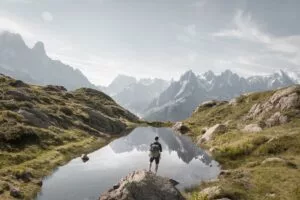
Hiking Guide: Getting the Most out of Day-hiking and Backpacking
Hiking can be the best way to enjoy the sights and sounds of nature. This guide will help you get started.

The Best Hiking Boots and Trail Shoes in Canada
Boots and shoes are perhaps the most important piece of gear for any hiker.
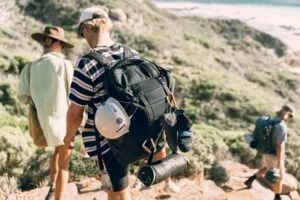
The Best Hiking Backpacks in Canada
Hiking backpacks are an important thing to have for a hike. That’s why we created this buying guide.
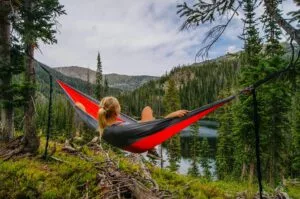
The Best Hammocks for Camping in Canada
Hammock camping can be one of the most comfortable ways to enjoy the outdoors.
